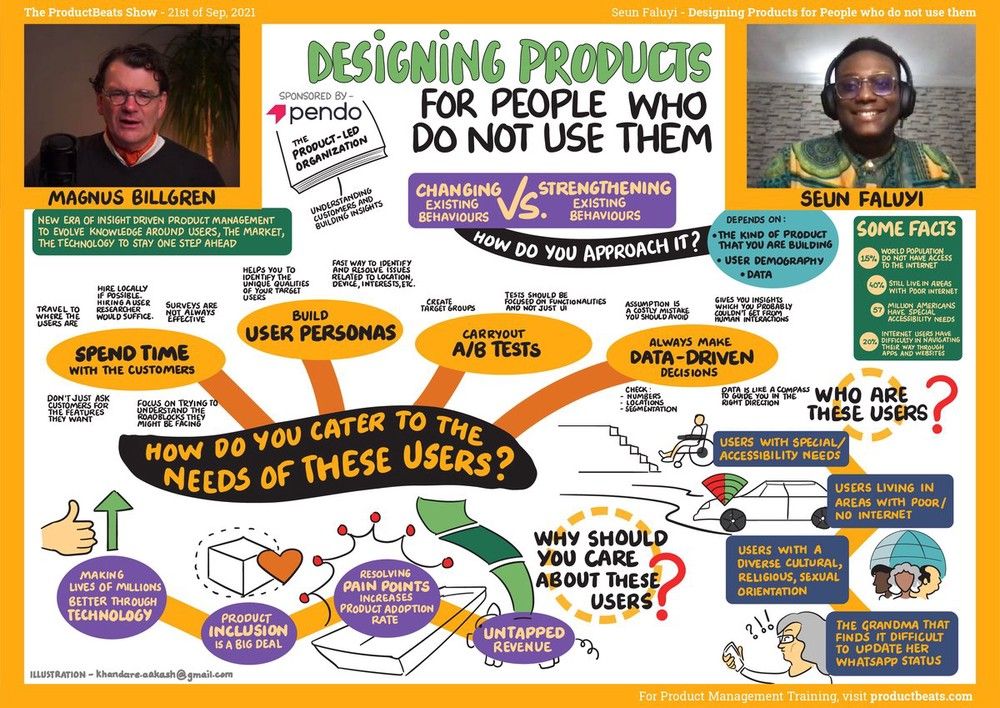Episode 74: Designing Products for people who do not use them w/Seun Faluyi
21 SEPTEMBER, 2021 / Host: MAGNUS BILLGREN
Insights for Working With Non-User Audiences
In product management, the focus has shifted from measuring metrics and analyzing data to building insights and conducting business experiments. However, a significant challenge arises when designing products for a customer group that does not show much interest or usage. This can include individuals with limited digital experience, people in areas with poor internet connectivity, or those who face accessibility barriers. In this episode of The Productbeats Show, we delve into the topic of designing products for such users, featuring Seun Faluyi, an expert product manager from Nigeria who has faced this dilemma numerous times. He shares his insights on how to overcome obstacles and effectively design products for people who may not be actively using them.
Understanding the Customer Group
Before addressing the strategies for designing products for non-users, it is essential to comprehend the characteristics of this customer group. Approximately 15% of the global population has access to the internet, with around 40% residing in areas with limited internet connectivity. Moreover, millions of individuals face challenges due to physical impairments or other accessibility needs. Additionally, cultural differences, personal preferences, and even language barriers can impact user adoption. Therefore, it becomes crucial to identify and address these challenges while building technology solutions.
Identifying Non-User Categories
Seun Faluyi outlines several categories of users who may not adopt products and explores the reasons behind their behavior. These categories include individuals with special needs, such as those with visual impairments or physical disabilities, who may find certain applications difficult to use. Furthermore, users in areas with poor internet connectivity may face obstacles that prevent them from fully utilizing digital products. Cultural differences and lifestyle misalignments can also influence user adoption. By understanding these categories, product managers can develop targeted strategies to address the needs of these non-users effectively.
Case Study: Pain Points of Users in Areas with Limited Connectivity
Using Lagos as a case study, Faluyi highlights the challenges faced by users in locations with poor internet connectivity. He explores the example of ride-hailing applications like Uber, where interruptions in connectivity can result in incorrect fare calculations. To address this pain point, Faluyi suggests the inclusion of offline map features, enabling drivers to calculate trip costs accurately even with limited connectivity. This case study emphasizes the importance of understanding the specific challenges faced by users in different locations and tailoring product features accordingly.
Why Should You Care?
It is essential for product managers to care about non-users for several reasons. Firstly, neglecting this demographic may result in lost revenue opportunities. By addressing the pain points of non-users, businesses can tap into new revenue streams and expand their customer base. Secondly, focusing on product inclusion ensures that the lives of various user groups are improved. Inclusive products contribute to a more equitable digital landscape, fostering positive social impact. Lastly, addressing the needs of non-users can enhance product adoption rates, leading to increased market penetration and competitive advantage.
Strategies for Designing Products for Non-Users
Faluyi shares valuable strategies for designing products for non-users, drawing from his own experience. One approach is to spend time with non-users to understand their challenges and troubleshoot issues. Additionally, building diverse product teams that include members from different locations can provide unique perspectives and insights. Global and local user considerations can be incorporated, as demonstrated by companies like Microsoft. Employing A/B testing helps identify functionalities that work best for different user segments, ensuring that decisions are data-driven. Moreover, product managers should prioritize functionality over design, focusing on the core problem-solving aspects of the product. Lastly, relying on data to guide decision-making helps reduce assumptions and create intelligent solutions that cater to non-user needs effectively.
Takeaways
- Understand the Challenges: When designing products for individuals who do not use them, it is crucial to understand the unique challenges they face. This includes considering factors such as limited internet connectivity, accessibility needs, cultural differences, and usability issues. By empathizing with these users and identifying their pain points, you can tailor your product to better meet their needs.
- Diverse Perspectives and Testing: Building a diverse product team that includes individuals from different locations and backgrounds can provide valuable insights and ideas. Conducting A/B tests and gathering data-driven feedback allows you to test functionalities rather than just focusing on user interface design. Letting data guide your decisions and challenging assumptions can lead to more effective product development.
- Inclusion and Revenue Potential: Designing products for non-user audiences not only addresses inclusion and social impact but also presents a significant revenue opportunity. By solving the pain points of these users and increasing adoption rates, you can tap into new markets and expand your customer base. Prioritizing the needs of non-user demographics can lead to improved customer experiences and higher revenue potential.
Speaking of effective product development, a great way to enhance your product management skills and stay ahead in the field is by enrolling in The Productbeats Product Management Certification Program. This comprehensive program offers a range of courses and resources designed to equip you with the knowledge and tools necessary to excel in product management. By honing your skills in areas such as user research, product strategy, and data analysis, you'll be better prepared to tackle the challenges of designing products for diverse audiences, including non-user demographics. Invest in your professional growth and join The Productbeats Product Management Certification Program today to take your product management expertise to the next level.
You might also enjoy watching...
Copyright © 2023 ProductBeats AB

Get The Program Brochure
Submit the form below to have The Program Brochure delivered to your inbox
The title of the notification
The descriptive text of the notification


